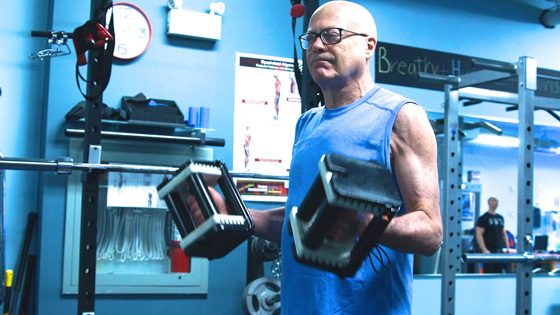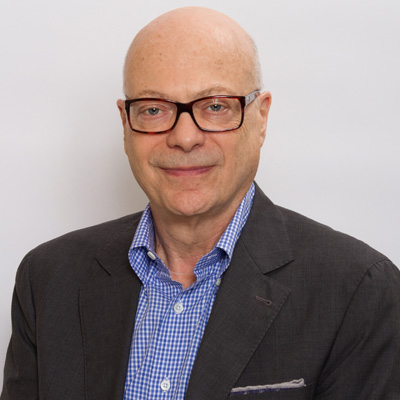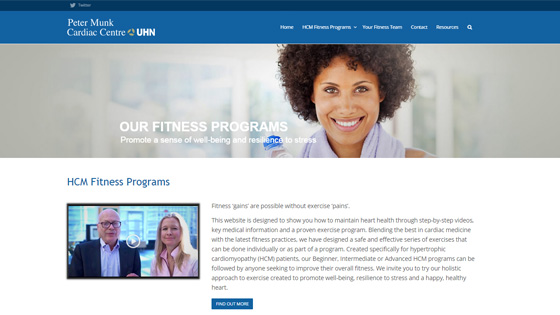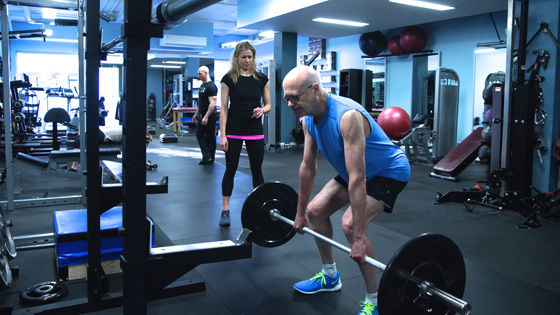
Dr. Harry Rakowski, cardiologist, Peter Munk Cardiac Centre, and fitness trainer Sarah Harris have designed a safe and effective exercise routine for patients with hypertrophic cardiomyopathy (HCM), a cardiac condition characterized by an enlarged heart muscle. The fitness program is also recommended for anyone looking to improve their heart health. (Photo: PMCC)
Dr. Harry Rakowski is a cardiologist at the Peter Munk Cardiac Centre, Professor of Medicine, University of Toronto and Director of the Hypertrophic Cardiomyopathy Clinic, Toronto General Hospital, University Health Network. He shared his personal fitness and overall wellness journey with UHN News.
The tipping point for me came in 2012.
A frozen shoulder and a sore neck impeded my daily activities as a cardiologist at the Peter Munk Cardiac Centre, as a husband, as a father and as a grandfather – so much so that I had finally had enough.
My chiropractor pointed me to a fitness studio to address my shoulder and neck issue. Before coming to the fitness studio, I had been training for over 25 years with a 'no pain, no gain' philosophy which was just not right.
The subsequent encounter I had with Michael Okamura and Sarah Harris at Fusion Studio set me on the right path.
At age 66, it has put me in better shape than I was when I was 40.
Related to this story:
I learned how to deal with the limitations too often imposed by getting older.
I walked taller, I ate better, my balance improved and I learned how to use breathing and mindfulness to better deal with everyday stress. Now I have trouble remembering which shoulder was the problem.
I am pain free.
A more holistic approach to patient care
This change helped me take a more holistic approach to the patients I saw in a busy clinical practice.
I became more aware of how some of my patients weren't aging gracefully or were training improperly. I could always expertly deal with their heart issues but now I saw the signs: a stooped neck, a lack of balance leading to falls, and a sore neck and back. I then started to focus more on why some patients were unfit and how to correct it.

Dr. Rakowski is a cardiologist at the Peter Munk Cardiac Centre who specializes in hypertrophic cardiomyopathy. (Photo: PMCC)
I see patients with all forms of heart disease but particularly specialize in a cardiac condition called hypertrophic cardiomyopathy, also known as HCM. This condition is found in one in 500 people and is associated with thickened heart muscle and sometimes scarring that can cause limiting symptoms and has a small risk of sudden cardiac death.
HCM is the leading cause of sudden death in young athletes in North America. In fact, I was part of an American guideline-writing group that defined how to manage this condition.
I have lectured around the world on HCM and the challenge of how to safely and effectively allow patients to preserve fitness while limiting risk was a universal problem. Previously, we had imposed limitations to physical activity that frustrated my patients and often made them more unfit and unhappy. Many experts felt that we were being overly restrictive but didn't know how to fix it.
Once I corrected my fitness routine, I realized that my two worlds had collided. A perfect storm was set into motion.
An innovative solution
The advice I started to give my patients now included lessons that I had learned from my own experience, but it wasn't enough. I sent a number of patients for personal training which was very effective, but many patients lived far away from Toronto or didn't have the resources needed for private training.
My academic training told me that I needed to do something more detailed and effective. Instead of just publishing research results to guide management, I needed to help create a tool for self-help.
Given the Peter Munk Cardiac Centre's entrenched focus on innovation, we decided a proactive, novel resource that could be accessed by anyone at any time was necessary.

Combining cardiac medicine with fitness research, Dr. Harry Rakowski, cardiologist, Peter Munk Cardiac Centre, and Sarah Harris, personal trainer, have created an online fitness program that takes a novel, holistic approach to exercise. (Photo: PMCC)
We took the best of medicine and coupled it with the latest in fitness, wellness and exercise research put together by Sarah Harris, an elite personal trainer and yoga instructor. From there, we produced a web-based platform with over 70 exercises aimed at promoting heart-healthy and pain-free lifestyle. The funding was provided by philanthropy.
We can all benefit from relatively safe and effective exercises that target stability, core musculature, endurance, strength, posture and relaxation techniques.
I'm certainly proof of that and so too are many of my patients who have started to adopt the program we developed.
“At age 66, it has put me in better shape than I was when I was 40.”
Dr. Harry Rakowski, Cardiologist, Peter Munk Cardiac Centre
The program is located at
Hypertrophic cardiomyopathy fitness programs and can be accessed through
the Peter Munk Cardiac Centre website.
When you log on you have to sign a disclaimer saying that you are stable enough to exercise, which is something that you may have to discuss with your physician. The program then is divided into the segments for beginner, intermediate and advanced levels that you can progress through depending on your ability.
There are highlighted diagrams that show the muscles each exercise targets, still photos demonstrating the techniques, a video clip that shows how to perform the routine and instructions on how to overcome challenges.
Little equipment is required and the programs can be done at home, on the road or at your local fitness centre.

Dr. Rakowski counts himself as proof that a targeted fitness routine can improve all-around wellness. (Photo: PMCC)
While the programs were designed for HCM patients, they can be done by most other stable cardiac patients and are wonderful for people without heart issues. I am one example of someone who's benefitted.
Bottom line: when deciding to adopt an effective exercise regimen ensure safety first – whether you have a heart condition or not.
A cursory understanding of how certain physical movements or exercises affect the body physiologically is helpful so that you are sure what you are doing will indeed benefit the area of your body being targeted. If something hurts or doesn't feel right, stop.
Don't focus on 'no pain, no gain.' Instead, focus on a holistic approach to health and wellness.
Stand tall, learn to relax, feel toned and healthy and enjoy the pleasures of life to the fullest.
Your well-being will be the success.
